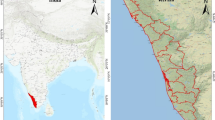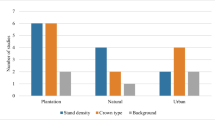Abstract
Given that the distribution of trees is irregular and individual trees differ from one another, applying a Digital Terrain Model (DTM) for cityscapes to a forest inventory causes many errors. In this study, a new DTM-generating technique that utilizes airborne Light Detection And Ranging (LiDAR), with iterative labeling for recovery of ground points, is proposed to solve the inaccuracy problem that occurs when DTMs are generated in forested areas. The proposed method consists of three steps: (1) generation of the initial DTM by a process that performs mean planar filtering and multireturn filtering, (2) recovery of ground points by iterative labeling through application of a ground extraction filter and limitation conditions, and (3) refinement to create the final DTM. The proposed method was tested at the experimental site with morphological and TerraScan DTM-generating techniques, followed by a visual assessment and a quantitative accuracy assessment through comparison with in-situ data. In the visual assessment, the proposed method exhibits such advantages as less noise and more precise representation of topographic features. Also, the method shows excellent performance in improving the average absolute deviation values of 110.3 cm and 50.4 cm over the morphological method and the TerraScan method, respectively, in the quantitative assessment. Thus, the proposed method is judged to have successfully solved the inaccuracy problem that often occurs with generation of DTMs for a forested area.
Similar content being viewed by others
References
Arefi, H., Engels, J., Hahn, M., and Mayer, H. (2007). “Automatic DTM generation from laser-scanning data in residential hilly area.” Proceedings of ISPRS Joint Workshop: Visualization and Exploration of Geospatial Data, Stuttgart, Germany.
Baltsavias, E., Gruen, A., Küchler, M., Thee, P., Waser, L. T., and Zhang, L. (2006). “Tree height measurements and tree growth estimation in a mire environment using digital surface models.” Workshop on 3D Remote Sensing in Forestry, Vienna, Session 2a, pp. 44–54.
Chang, A. J., Eo, Y. D., Kim, Y. M., and Kim, Y. I. (2013). “Identification of individual tree crowns from LiDAR data using a circle fitting algorithm with local maxima and minima filtering.” Remote Sensing Letter, Vol. 4, No. 1, pp. 29–37, DOI: 10.1080/2150704X.2012.684362.
Chen, Q., Gong, P., Baldocchi, D. D., and Xie, G. (2007). “Filtering airborne laser scanning data with morphological methods.” Photogrammetric Engineering & Remote Sensing, Vol. 73, No. 2, pp. 175–185, DOI: 10.14358/PERS.73.2.175.
Edson, C. and Wing, M. (2011). “Airborne Light Detection and Ranging (LiDAR) for individual tree stem location, height, and biomass measurements.” Remote Sensing, Vol. 3, No. 11, pp. 2494–2528, DOI: 10.3390/rs3112494.
Filin, S. and Pfeifer, N. (2009). “Segmentation of airborne laser scanning data using a slope adaptive neighborhood.” ISPRS Journal of Photogrammetry and Remote Sensing, Vol. 60, No. 2, pp. 71–80, DOI: 10.1016/j.isprsjprs.2005.10.005.
Hu, Y. (2003). Automated extraction of digital terrain models, roads and buildings using airborne LiDAR data, PhD Thesis, Department of Geomatics Engineering, The University of Calgary, Calgary, Alberta, Canada.
Jacobsen, K. and Lohmann, P. (2003). “Segmented filtering of laser scanner DSMs.” Proceedings of the ISPRS Working Group III/3 workshop: 3-D Reconstruction from Airborne Laserscanner and InSAR Data, Dresden, Germany.
James, L. A., Watson, D. G., and Hansen, W. F. (2007). “Using LiDAR data to map gullies and headwater streams under forest canopy: South Carolina, USA.” Catena, Vol. 71, No. 1, pp. 132–144, DOI: 10.1016/j.catena.2006.10.010.
Jeon, M. C., Jung, T. W., Eo, Y. D., and Kim, J. K. (2010). “Estimation of tree heights from seasonal airborne LiDAR data.” Korean Soc. Surveying, Geod., Photogramm. Cartogr., Vol. 28, No. 4, pp. 441–448.
Kim, Y. M., Eo, Y. D., Chang, A. J., and Kim, Y. I. (2013). “Generation of a DTM and building detection based on an MPF through integrating airborne lidar data and aerial images.” International Journal of Remote Sensing, Vol. 34, No. 8, pp. 2947–2968, DOI: 10.1080/01431161.2012.756597.
Kobler, A., Pfeifer, N., Ogrinc, P., Todorovski, L., Oštir, K., and Džeroski, S. (2007). “Repetitive interpolation: A robust algorithm for DTM generation from aerial laser scanner data in forested terrain.” Remote Sensing of Environment, Vol. 108, No. 1, pp. 9–23, DOI: 10.1016/j.rse.2006.10.013.
Korea Forest Service. (2009). “Stand volume, tree weight, and stand yield table.” A Periodical Publication of Korea Forest Service, 11-1400000-000382-14, Korea Forest Service.
Ma, R. (2005). “DEM generation and building detection from LiDAR data.” Photogrammetric Engineering & Remote Sensing, Vol. 71, No. 7, pp. 847–854, DOI: 10.14358/PERS.71.7.847.
Meng, X., Currit, N., and Zhao, K. (2010). “Ground filtering algorithms for airborne LiDAR data: A review of critical issues.” Remote Sensing, Vol. 2, No. 3, pp. 833–860, DOI: 10.3390/rs2030833
Meng, X., Wang, L., and Currit, N. (2009a). “Morphology-based building detection from airborne LIDAR data.” Photogrammetric Engineering & Remote Sensing, Vol. 75, No. 4, pp. 437–442, DOI: 10.14358/PERS.75.4.437.
Meng, X., Wang, L., Silván-Cárdenas, J. L., and Currit, N. (2009b). “A multi-directional ground filtering algorithm for airborne LIDAR.” ISPRS Journal of Photogrammetry and Remote Sensing, Vol. 64, No. 1, pp. 117–124, DOI: 10.1016/j.isprsjprs.2008.09.001.
Nicholas, R., Vaughn, L., Monika M., and Eric C. T. (2012). “Tree species detection accuracies using discrete point LiDAR and airborne waveform LiDAR.” Remote Sensing, Vol. 4, No. 2, pp. 377–403, DOI: 10.3390/rs4020377.
Rabbania, T., Van den Heuvelb, F. A., and Vosselmanc, G. (2006). “Segmentation of point clouds using smoothness constraint.” The International Archives of the Photogrammetry, Remote Sensing and Spatial Information Sciences, Vol. 36, No. 5, pp. 248–253.
Reutebuch, S. E., McGaughey, R. J., Andersen, H. E., and Carson, W. W. (2003). “Accuracy of a high-resolution lidar terrain model under a conifer forest canopy.” Canadian Journal of Remote Sensing, Vol. 29, No. 5, pp. 527–535, DOI: 10.5589/m03-022.
Roggero, M. (2001). “Airborne laser scanning: Clustering in raw data.” The International Archives of the Photogrammetry, Remote Sensing and Spatial Information Sciences, XXXIV, pp. 227–232.
Schiewe, J. (2001). “Ein regionen-basiertes Verfahren zur Extraktion der Gelandeoberflache aus Digitalen Oberflachen-Modellen.” Photogrammetrie Fernerkundung Geoinformation, Nr. 2, pp. 81–90.
Silváan-Cáardenas, J. L. and Wang, L. (2006). “A multi-resolution approach for filtering LiDAR altimetry data.” ISPRS Journal of Photogrammetry and Remote Sensing, Vol. 61, No. 1, pp. 11–22, DOI: 10.1016/j.isprsjprs.2006.06.002.
Sithole, G. and Vosselman, G. (2005). “Filtering of airborne laser scanner data based on segmented point clouds.” Proceedings of ISPRS Workshop Laser Scanning, Enschede, the Netherlands, pp. 66–71.
St-Onge, B. A. and Achaichia, N. (2001). “Measuring forest canopy height using a combination of LiDAR and aerial photography data.” International Archives of Photogrammetry and Remote Sensing, XXXIV-3/W4, pp. 131–137.
Sulaiman, N. S., Majid, Z. and Setan, H. (2010). “DTM generation from LiDAR data by using different filters in open-source software.” Geoinformation Science Journal, Vol. 10, No. 2, pp. 89–109.
Susaki, J. (2012). “Adaptive slope filtering of airborne LiDAR data in urban areas for Digital Terrain Model (DTM) generation.” Remote Sensing, Vol. 4, No. 4, pp. 1804–1819, DOI: 10.3390/rs4061804.
Tóvári, D. and Pfeifer, N. (2005). “Segmentation based robust interpolation-a new approach to laser filtering.” The International Archives of the Photogrammetry, Remote Sensing and Spatial Information Sciences, Vol. 36, No. 3, pp. 79–84.
Wang, C., Menenti, M., Stoll, M. P., Alessandra, F., Enrica, B., and Marco, M. (2009). “Separation of ground and low vegetation signatures in LiDAR measurements of salt-marsh environments.” IEEE Transactions on Geoscience and Remote Sensing, Vol. 47, No. 7, pp. 2014–2023, DOI: 10.1109/TGRS.2008.2010490.
Yuan, F., Zhang, J., Zhang, L., and Gao, J. (2009). “Urban DEM generation from airborne LiDAR data.” Joint Urban Remote Sensing Event, CD-ROM, DOI: 10.1109/URS.2009.5137643.
Zhang, K., Chen, S., Whitman, D., and Shyu, M. (2003). “A progressive morphological filter for removing nonground measurements from airborne LiDAR data.” IEEE Transactions on Geoscience and Remote Sensing, Vol. 41, No. 4, pp. 872–882, DOI: 10.1109/TGRS.2003.810682.
Author information
Authors and Affiliations
Corresponding author
Rights and permissions
About this article
Cite this article
Kim, Y., Eo, Y.D. Ground point extraction by iterative labeling of airborne LiDAR data in a forested area. KSCE J Civ Eng 19, 2233–2239 (2015). https://doi.org/10.1007/s12205-015-0319-y
Received:
Revised:
Accepted:
Published:
Issue Date:
DOI: https://doi.org/10.1007/s12205-015-0319-y




